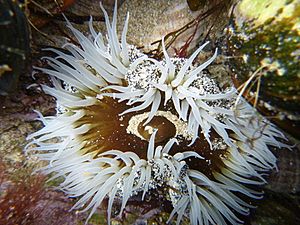Giant shore anemone facts for kids
Quick facts for kids Giant shore anemone |
|
|---|---|
 |
|
| Scientific classification |
The Oulactis magna, also known as the giant shore anemone or camouflaged anemone, is a common sea anemone found in New Zealand. Its Māori name is kōtore tino nui.
These amazing creatures live in the ocean, usually in the middle to lower parts of beaches where the tide goes in and out. You can often spot them in tidal pools or hidden among rocks where there is sand.
The giant shore anemone is super good at hiding! Its body is often covered in sand, with only its colorful tentacles showing. It even sticks pieces of shell and other bits of debris onto its body. This helps protect it from strong waves and currents.
While it doesn't have many known enemies, a tiny snail called Epitonium jukesianum sometimes bothers it. This snail uses a special tooth, like a tiny straw, to gently sip fluids from the anemone.
What Does a Giant Shore Anemone Look Like?
This is a pretty big anemone! It can grow to be about 10 to 12 centimeters wide. That's about the size of a large orange.
One of the coolest things about them is their bright colors. The center part of the anemone, called the disc, can be green, pink, blue, or even brown.
Their tentacles are usually a different color from the center. You might see blue, mauve, orange, or white tentacles swaying in the water.
When the anemone is underwater, it stretches out up to 190 short, blunt tentacles. The tips of these tentacles look a bit like warts and have tiny holes. If you gently touch one (don't do this in the wild!), it might squirt out fine streams of water. The tentacles are arranged in several circles, and they are all about the same length.
What Do Giant Shore Anemones Eat?
Giant shore anemones are hunters! They eat small shrimp, tiny fish, and little crabs.
They catch their food using special stinging cells on their tentacles. These cells help to paralyze their prey, making it easier to grab.
Once they catch something, they pull it into their central opening. Inside, special juices break down the food. Anything they can't digest, like shells, gets pushed back out through the same opening.

